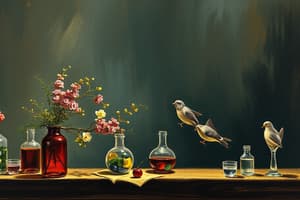Podcast
Questions and Answers
Which element is typically found in most biomolecules?
Which element is typically found in most biomolecules?
- Oxygen (correct)
- Phosphorus
- Hydrogen
- Iron
Which of the following is NOT a monomer of carbohydrates?
Which of the following is NOT a monomer of carbohydrates?
- Amino acids (correct)
- Galactose
- Fructose
- Glucose
What is the primary storage form of glucose in animals?
What is the primary storage form of glucose in animals?
- Starch
- Glycogen (correct)
- Chitin
- Cellulose
What is the molecular ratio of hydrogen to oxygen in carbohydrates?
What is the molecular ratio of hydrogen to oxygen in carbohydrates?
Which of these is a disaccharide?
Which of these is a disaccharide?
What type of energy is associated with the movement of charged particles?
What type of energy is associated with the movement of charged particles?
What is the role of enzymes in chemical reactions?
What is the role of enzymes in chemical reactions?
What happens when all enzymes become busy during a reaction?
What happens when all enzymes become busy during a reaction?
Which form of energy involves stored energy based on position?
Which form of energy involves stored energy based on position?
What can be inferred about the conversion of energy during reactions?
What can be inferred about the conversion of energy during reactions?
What happens to an enzyme when an inhibitor is added?
What happens to an enzyme when an inhibitor is added?
What is the primary characteristic of water that contributes to its high specific heat?
What is the primary characteristic of water that contributes to its high specific heat?
Why is water considered a good lubricant?
Why is water considered a good lubricant?
How does water's unique property of solubility affect its role as a solvent?
How does water's unique property of solubility affect its role as a solvent?
What occurs when water evaporates from the body?
What occurs when water evaporates from the body?
What type of bond is formed when two oxygen atoms come together?
What type of bond is formed when two oxygen atoms come together?
In the reaction between Na and Cl, which statement correctly describes the electron transfer?
In the reaction between Na and Cl, which statement correctly describes the electron transfer?
Which of the following is characteristic of organic compounds?
Which of the following is characteristic of organic compounds?
How do chemical reactions occur?
How do chemical reactions occur?
Which type of chemical reaction involves the formation of a single product from multiple reactants?
Which type of chemical reaction involves the formation of a single product from multiple reactants?
What factor does NOT influence the rate of chemical reactions?
What factor does NOT influence the rate of chemical reactions?
In which type of reaction are molecules broken down into smaller molecules?
In which type of reaction are molecules broken down into smaller molecules?
What role do enzymes play in chemical reactions?
What role do enzymes play in chemical reactions?
What is formed when two or more atoms are held together by a bond?
What is formed when two or more atoms are held together by a bond?
Which statement accurately describes cations?
Which statement accurately describes cations?
What type of bond is characterized by the sharing of electrons between atoms?
What type of bond is characterized by the sharing of electrons between atoms?
In what type of covalent bond are electrons shared unequally between atoms?
In what type of covalent bond are electrons shared unequally between atoms?
How do hydrogen bonds primarily differ from ionic bonds?
How do hydrogen bonds primarily differ from ionic bonds?
When sodium chloride (NaCl) is placed in water, _____.
When sodium chloride (NaCl) is placed in water, _____.
What type of molecule is water due to its polar bonds?
What type of molecule is water due to its polar bonds?
Which of the following statements about ionic compounds is true?
Which of the following statements about ionic compounds is true?
What aspect differentiates isotopes from one another?
What aspect differentiates isotopes from one another?
Which of the following subatomic particles has no charge?
Which of the following subatomic particles has no charge?
How many electrons can the first electron shell hold?
How many electrons can the first electron shell hold?
What condition must be met for an atom to be considered chemically stable?
What condition must be met for an atom to be considered chemically stable?
What is the atomic mass of an atom calculated from?
What is the atomic mass of an atom calculated from?
What role do electrons play in the chemical reactivity of an atom?
What role do electrons play in the chemical reactivity of an atom?
What is an example of a major element found in the human body?
What is an example of a major element found in the human body?
What happens to atoms when they do not have a full valence shell?
What happens to atoms when they do not have a full valence shell?
Flashcards
What is an atom?
What is an atom?
The smallest stable non-living unit that makes up all matter.
What is the nucleus?
What is the nucleus?
The center of an atom, containing protons and neutrons.
What is a proton?
What is a proton?
A subatomic particle found in the nucleus of an atom, with a positive charge (+1) and a mass of one atomic mass unit (amu).
What is a neutron?
What is a neutron?
Signup and view all the flashcards
What is an electron?
What is an electron?
Signup and view all the flashcards
What is the atomic number?
What is the atomic number?
Signup and view all the flashcards
What is the atomic mass?
What is the atomic mass?
Signup and view all the flashcards
What is an isotope?
What is an isotope?
Signup and view all the flashcards
Molecule
Molecule
Signup and view all the flashcards
Compound
Compound
Signup and view all the flashcards
Ion
Ion
Signup and view all the flashcards
Ionic bond
Ionic bond
Signup and view all the flashcards
Covalent bond
Covalent bond
Signup and view all the flashcards
Nonpolar Covalent Bond
Nonpolar Covalent Bond
Signup and view all the flashcards
Polar Covalent Bond
Polar Covalent Bond
Signup and view all the flashcards
Hydrogen Bond
Hydrogen Bond
Signup and view all the flashcards
Combination reaction
Combination reaction
Signup and view all the flashcards
Decomposition reaction
Decomposition reaction
Signup and view all the flashcards
Exchange reaction
Exchange reaction
Signup and view all the flashcards
Catalyst
Catalyst
Signup and view all the flashcards
Enzymes
Enzymes
Signup and view all the flashcards
Metabolism
Metabolism
Signup and view all the flashcards
What is energy?
What is energy?
Signup and view all the flashcards
What is work?
What is work?
Signup and view all the flashcards
What is potential energy?
What is potential energy?
Signup and view all the flashcards
What is kinetic energy?
What is kinetic energy?
Signup and view all the flashcards
What is an enzyme?
What is an enzyme?
Signup and view all the flashcards
Polymers
Polymers
Signup and view all the flashcards
Monosaccharides
Monosaccharides
Signup and view all the flashcards
Glucose
Glucose
Signup and view all the flashcards
What happens to an enzyme when it is denatured?
What happens to an enzyme when it is denatured?
Signup and view all the flashcards
Glycogen
Glycogen
Signup and view all the flashcards
Disaccharide
Disaccharide
Signup and view all the flashcards
How do inhibitors affect enzyme activity?
How do inhibitors affect enzyme activity?
Signup and view all the flashcards
What makes water a polar molecule?
What makes water a polar molecule?
Signup and view all the flashcards
Why does water have a high specific heat?
Why does water have a high specific heat?
Signup and view all the flashcards
Why is water called the "universal solvent"?
Why is water called the "universal solvent"?
Signup and view all the flashcards
Study Notes
Chemical Level of Organization
- Atoms, molecules, elements, and compounds are key components of the chemical level of organization
- Atoms are the fundamental building blocks of matter, composed of protons (+ charge), neutrons (0 charge), and electrons (- charge)
- Protons and neutrons are located in the nucleus, while electrons orbit the nucleus in electron shells
- Atoms have a neutral charge (number of protons = number of electrons)
- The number of electrons in the outermost shell (valence shell) determines an atom’s chemical stability
- Atoms are reactive if their outermost shell is not full
- Atoms gain, lose, or share electrons to achieve a complete valence shell (octet rule)
- Atoms that gain or lose electrons convert to ions (cations for positive, and anions for negative ions)
- Chemical bonds (ionic, covalent, hydrogen) form between atoms to create molecules and compounds
- Ionic bonds involve the transfer of electrons between atoms
- Covalent bonds involve the sharing of electrons between atoms (Polar covalent and Nonpolar covalent)
- Hydrogen bonds form between molecules, not atoms
- Water is a vital substance due to its properties of high specific heat, thermal inertia and solubility
- Water is polar, an excellent solvent, and critical for many biological processes.
- Several terms define mixtures in water (solution, solute, solvent, colloid, suspension)
- Water's unique properties profoundly impact biological systems
- pH, acids, and bases describe the level of hydrogen ions (H+) in a solution
- Buffers help control pH fluctuations in biological systems
- Enzymes are biological catalysts that speed up chemical reactions in cells by lowering the activation energy
- Proteins, carbohydrates, lipids, and nucleic acids are crucial biological macromolecules essential to life's processes.
- These macromolecules have specific building blocks (monomers) and can form larger structures (polymers) to perform various functions in the body
Studying That Suits You
Use AI to generate personalized quizzes and flashcards to suit your learning preferences.
Related Documents
Description
Test your knowledge on the chemical level of organization, focusing on atoms, molecules, elements, and compounds. This quiz covers the structure of atoms, types of chemical bonds, and the role of valence electrons in chemical stability. Challenge yourself with questions about the fundamental concepts of chemistry!




